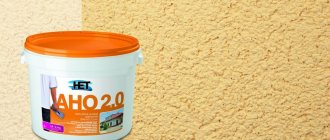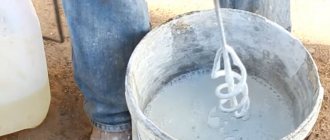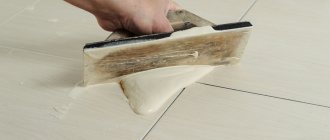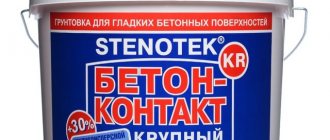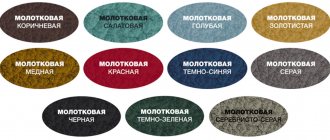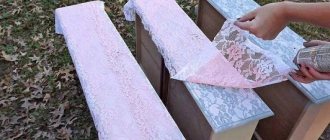Varnish for tiles and tiles: composition, characteristics and scope of application
Author: Anastasia Isakova · Published 07/08/2017 · Updated 07/08/2017
After the repair is completed, stains form on the surface of the ceramic tiles, the tiles fade, and scratches may appear on the surface during use. Moisture also accumulates in the tile joints during operation. This is true for porous types of floor tiles with a matte surface - such a floor is much more exposed to various mechanical stress and contamination. Don't despair and go to hardware stores. Using tile varnish, you can restore the aesthetics of the coating.
The varnishing process not only protects the surface from inevitable damage, but also provides contrasting colors and shades, and the floor will look fresh for several years. Many people are also concerned about the question of whether it is possible to varnish tiled floors. Yes, because this paint and varnish is intended specifically for such coatings, it turns out that it is not only possible, but also necessary.
Varnish composition
Varnish for ceramic tiles is often made on the basis of acrylic resins with the inclusion of tiny ceramic particles. These materials may also include urethane polymers dissolved in aliphatic solvents.
After application and complete drying, such a coating will have a glossy shine and high strength - this will protect the tile from various damages.
Scope of use
Tile varnish is used for:
- highly absorbent ceramic tiles (Tuscan tiles, terracotta);
- facing work, when the seam is made of cement;
- finishing of natural or artificial stone, brick;
- application on floors made of concrete, natural or agglomerated stone.
Varnish is also widely used for paving slabs; it is also suitable for clinker tiles; it not only gives an aesthetic appearance to the material, but also reliably protects its surface.
In the video: using varnish for paving slabs.
Advantages and disadvantages
Thus, after application, a durable protective coating is created. Using these materials, you can update the look of old tiles, thereby breathing new life into them - this also allows you to save money. Sometimes after coating with varnish the floor becomes less slippery.
For tiles that are exposed to high humidity and temperature changes, acrylic compounds will prevent their destruction by clogging the pores of the ceramic. After applying the materials, surface care is greatly simplified - practically no dirt accumulates on the varnish. The color of floor and any other tiles will never fade, since varnishes allow you to preserve the tiles for many years.
If you violate the technology and cover the surface incorrectly, the appearance of the tile will significantly deteriorate. If there is a lot of traffic in the room, the coating will be erased despite the reliability of the protective layer. It is also very difficult to clean hardened varnish from floor tiles.
Material consumption
The consumption of varnishes for porcelain stoneware and tiles depends on the degree of porosity. Due to this porosity, the tiles are covered in several layers. Also, the shade significantly affects the consumption - to achieve the desired aesthetic result, one layer may not be enough.
As for the consumption of paints and varnishes for a tiled surface, it ranges from 100 to 200 g per 1 m2.
Instructions for use
Before applying varnish, it is necessary to prepare the floor surface. It must be completely dry and free of dust or other contaminants. Any remaining cement must be removed and the seams leveled.
The material is applied using soft gauze. The piece must be perfectly clean. The fabric should not have lint. A soft brush will also work.
Apply the varnish as evenly as possible. Do not pour out all the material at once and then distribute it - this can lead to sagging and stains. Then the layer is given time to absorb - 2-3 minutes, the excess is removed with a rag.
If terracotta, Tuscan tiles and other highly absorbent materials are being varnished, the surface should be treated one more time to obtain a high-quality result. If the tile absorbs poorly, then the composition is applied only with soft fabrics to avoid streaks that can spoil the result.
After 12 hours you can start walking on the floor. If this material is used on a wall, then the principle of application is the same.
These coatings can also be used for pre-treatment of Tuscan tiles and easily absorbent tiles before laying them on an adhesive or cement mixture. This will help remove the finished tiles. But terracotta should not be pre-treated - there is a risk of fading.
Additional recommendations
For work on Tuscan tiles, terracotta, and highly absorbent coatings, it is recommended, if possible, to avoid using varnish until the adhesive has completely cured. The curing process can take months. When laying on a dry screed with cement adhesives, the curing time is significantly shorter.
We recommend: Features and properties of aerosol paint
Before varnishing clinker, it is recommended to first treat the seams. Then, after finishing with varnish, the surface will look perfect if you decide to varnish the tiles.
There is a special varnish for processing stone - wet stone. It will reliably protect natural or artificial stone from aggressive influences.
When it is not possible to replace old tiles with new ones, then using varnishes you can give the floor or wall a completely new look. If the tiles have just been purchased, then the varnish coating will help protect them from moisture, from various mechanical influences, and from temperature changes. Varnishing will give a positive effect, and if the result is not to your liking, you can paint it. The varnish is also good because it can be applied independently.
Should I use tile varnish (2 videos)
Scope of use
Tile varnish is used for:
- highly absorbent ceramic tiles (Tuscan tiles, terracotta);
- facing work, when the seam is made of cement;
- finishing of natural or artificial stone, brick;
- application on floors made of concrete, natural or agglomerated stone.
Varnish is also widely used for paving slabs; it is also suitable for clinker tiles; it not only gives an aesthetic appearance to the material, but also reliably protects its surface.
In the video: using varnish for paving slabs.
Areas of application and technical parameters
Varnishing of tiles is used for the following coatings:
- absorbent ceramic tiles (for example, Tuscan tiles, terracotta, etc.);
- cladding with seams based on cement grout;
- cladding made of natural stone or brick;
- concrete floors, coverings made of natural and agglomerated stone, as well as paving slabs, etc.
This type of varnish is usually made on the basis of acrylic with the addition of very small particles of ceramics. Also, the tile varnish may include a urethane polymer dissolved in aliphatic solvents.
After drying, the treated surface becomes glossy and much stronger, which helps prevent mechanical damage.
The tiles are coated with a protective varnish to avoid fading and various mechanical damages.
Application technology
The base is first cleaned and sanded. The dust is removed again. Sometimes degreasing and priming are performed. The surface is dried before varnishing. The maximum permissible temperature when applying LM is 35 degrees above zero.
Multi-layer varnish coating. Apply at least 2 layers. Each subsequent layer is applied after the previous one has dried. The time interval between coating layers is about 5 hours. The lower the ambient temperature, the longer the varnish layer dries. The surface is completely ready for use within a day.
With some chemical compounds, the varnish is highly flammable. Therefore, you need to work with the material carefully, observing safety precautions. Individuals need personal protective equipment. Apply a layer with any painting tool. If a spray gun is used, the composition is checked for viscosity.
Types of protection products for ceramic granite
Impregnation, which is used to protect tiles, is called various means that differ from each other in composition and in the effect they perform. There are several types:
- Water repellent. Moisture-repellent agent for seams. How to varnish terracotta tiles for stoves? Forms a thin layer of protection, but is quickly destroyed in case of fur. influence.
- Polymer varnish for seams. When applied, the varnish provides a thick layer that even covers the grout structure.
- Silicone or acrylic sealants. Used for fixing contact surfaces of porcelain stoneware coverings with other materials or with plumbing products.
Advantages of terracotta tiles
The wide distribution of the tile covering in question in the decoration of fireplaces, stoves, and other surfaces of the apartment is due to:
- Unstrict geometric shapes that create a luxurious atmosphere of an aesthetically attractive interior.
- Masking defects. Cracks, deep seams and other problems with brickwork are easily hidden under the tiles.
- Updating the design, allowing surfaces to always correspond to modern trends in design art.
The durable structure of terracotta tiles can be used for a long period of time. It effectively resists the destructive effects of the heat generated by the fireplace, as well as seventy cycles of thawing and freezing. The interiors of baths, saunas and other periodically moistened rooms are decorated with a material that is unable to absorb liquids. The original color is preserved under the ultraviolet part of the radiation sent by the sun, and the natural environment is not polluted by the environmentally friendly components of the products in question. Thanks to this, the well-being of people in rooms decorated with terracotta does not deteriorate.
Why varnish tiles?
Beautiful surface cladding with high-quality installation does not require additional processing. The aesthetics of the coating largely depends on the appearance of the tile or ceramic, its palette, the design of one fragment, and the overall pattern. When getting started, it is important to read the label recommendations for applying floor tile varnish. Experiments by designers and decorators led to new “discoveries.” For example, we tried all the options for the design under the self-leveling floor – from photo wallpaper with a 3D effect to ceramic cladding. The tiled floor showed better qualities, and the protective cladding looks new.
Important! Tiles are made from white clay, ceramics are made from red or terracotta, porcelain stoneware is a harder material due to release technology.
If you use varnish for tiles, the protective coating will give the surface new properties:
- glossy effect;
- filling all the seams that are inevitable when joining piece facing material;
- the opportunity to modernize the interior using an accessible method;
- protection against abrasion and mechanical damage;
- extending the service life of expensive imported material.
Note! A high-tech coating based on acrylic “wet stone” has been developed, which looks very realistic in swimming pools, in places where flower beds are watered, near fountains, and artificial ponds.
Varnish is not applicable in all cases. Fireproof cladding should not be treated - it may ignite near a fireplace or other open hearth.
Varnished tiles
We recommend: Ideas on what color to paint the bedroom: photos and 6 basic colors
Tile varnish - composition, advantages, consumption, application rules
Ceramic and other tiles, some time after installation, begin to fade, stains appear on them, they are subject to mechanical damage, scratches and abrasions occur, and the seams between the tiles allow moisture to pass through. These problems arise especially often in porous tile materials that have a matte tint; they are susceptible to contamination and mechanical damage. To protect this material, experts recommend using tile varnish.
Thanks to varnishing, the surface becomes reliably protected from various damages and the harmful influence of external factors, in addition, the varnish makes the shade more contrasting and attractive, the floor acquires a rich color and a beautiful appearance.
Composition of the varnish mixture
Typically, varnish for ceramic floor tiles is made from acrylic resins with the addition of very small ceramic particles. In addition, the tile varnish may contain polyurethane polymer substances that are dissolved in an aliphatic solvent.
Depending on the composition, glossy and matte varnishes for tiles are produced. On a matte surface, dirt is less visible, while a glossy finish is shiny, reflects light well, and looks very attractive. Regardless of the type of gloss, each composition has a high level of strength and wear resistance, protecting ceramic tiles from damage.
Area of use
Tile varnishing is used for the following types of coating:
- cladding with cement-based joints;
- ceramic tiles that absorb moisture, for example, varnished Tuscan tiles or terracotta;
- protection of natural stone or bricks;
- treatment of concrete surfaces, including walls and floors;
- agglomerated or natural stone, all kinds of paving slabs;
- processing of clinker tiles.
Advantages and disadvantages
Varnishing ceramic tiles provides many undeniable advantages. After the varnish dries, a thin but very durable protective layer is created on the surface. Varnishing tiles, especially old tiles, can make them attractive again and save money. In addition, in some cases, after varnishing, the floor covering becomes less slippery.
If you varnish tiles that are in conditions of excessive air humidity and temperature fluctuations, the acrylic varnish mixture will protect the material from gradual destruction. The varnish fills all the microcracks and pores located on the surface of the new or old tile, as a result it remains protected from the absorption of moisture and water. After varnishing, it is much easier to care for the surface, since a flat and smooth wall or floor becomes dirty very slowly, and cleaning is done very quickly. After using tile varnish, this material will not fade, that is, its shade will not change over time, thanks to which the tile remains attractive for many years.
If you do not follow the varnishing technology and apply the varnish mixture incorrectly, the appearance of the coating will be ruined. And if you varnish a floor that a huge number of people walk on every day, the coating will wear off very quickly, despite the fact that it is durable and reliable. The old varnish layer, which has completely hardened, is quite difficult to remove.
Consumption
The consumption of tile varnish depends on how quickly the material absorbs liquid, as well as the temperature and humidity of the air. If the liquid is absorbed very quickly, you will have to varnish in several layers. In addition, in order to achieve the desired aesthetic result, it may be necessary to apply not one, but several layers of varnish; thanks to multi-layer varnish, the shade of the surface will change.
Typically, ceramic tile varnish does not wear out very quickly. The consumption of this paint and varnish material for tile materials is approximately 100-200 grams per square meter. Porous materials absorb varnish much faster, so consumption increases, but smooth, even tiles without pores absorb much less of the mixture, so consumption is minimal.
Varnishing tips
If you need to varnish terracotta tiles or Tuscan tiles or any other surfaces that quickly absorb liquid, you need to wait until the adhesive has completely hardened, otherwise the shade of the tile may fade. Sometimes you need to wait from several weeks to several months. But if the installation is carried out on a dry concrete screed, or cement-based adhesive is used, then the waiting period is significantly reduced.
It is not recommended to apply varnish to floor tiles in a very thick layer. It is better to apply 2-3 thin coats than one thick coat. You need to varnish evenly, avoiding gaps, and you should not allow sagging or the appearance of puddles, which will be too visible on a light-colored material. You can varnish with a regular piece of fabric.
Attention! It is highly not recommended to varnish a material whose base is not protected from moisture penetration.
It is allowed to varnish the tiles only after they have been cleaned of any contaminants, including cement residues, dirt, dust, grease, etc. The seams must be aligned. The varnish must be applied only to a dry and clean surface.
We recommend: MA-15 paint – description, technical characteristics and varieties
Rules for applying varnish
The varnish composition can be applied to floor or wall tiles using a brush, tassel or piece of soft cloth. If fabric is used, it should be lint-free. The composition is applied in an even layer; experts do not recommend using the pouring method, since if you pour the varnish onto the floor, then it is quite difficult to distribute it in an even layer on the base, as a result stains and sagging will appear.
When the solution is applied, you need to wait 10-15 minutes for the mixture to be absorbed, after which the residue is removed with a rag or rag. If you are varnishing Tuscan tiles or terracotta, you must apply two or three layers to achieve the desired result. If the material is smooth and practically does not absorb liquid, then you need to use only a soft cloth to avoid sagging, which will definitely ruin the appearance of the floor.
After 12 hours of varnishing, you can begin to walk on the floor. The process of applying varnish to wall tiles is exactly the same. Experts say that tile varnish can be used to varnish various quickly absorbing materials before gluing them to a concrete base, or before creating seams. Pre-varnishing will make cleaning much easier. However, there is no need to pre-varnish terracotta, as it may fade. Under normal conditions, the consumer characteristics of tile varnish compositions are maintained for one and a half to three years. When all work is completed, clothing, skin and tools used must be immediately washed with some solvent.
Safety precautions
When working with paints and varnishes, the following rules must be observed:
- You can only work with safety glasses and rubber gloves;
- It is recommended to wear a respirator that protects the respiratory system from harmful varnish vapors;
- storing varnish solution is usually allowed at temperatures from +5 to +25 degrees;
- It is prohibited to apply the composition near an open flame; you cannot smoke near an open container;
- the remaining mixture must not be discharged into the sewer system;
- the room where the varnish mixture is stored must be well ventilated;
- During the application of varnish, the room must be well ventilated.
How to choose varnish or paint for ceramic tiles, application instructions and safety precautions
Ceramic tile varnish can give a second life to old wall tiles or dull, worn flooring. Not many people know that building ceramics can be painted, artistically decorated and varnished, but this is also an excellent way to protect the surface from household dirt, scratches and moisture penetration. Let's try to figure out whether all paints and varnishes are suitable for these purposes.
Technical characteristics, composition and areas of application of varnish and paint
It is clear that the first jar you come across with a solution of natural or synthetic resins is not suitable for applying to ceramics. For this purpose, the construction industry has prepared products with a special composition.
Construction varnishes are solutions of synthetic and natural resins that are prone to film formation in water or organic compounds. To coat ceramic surfaces use:
- polyurethane varnishes (solutions of urethane polymers in aliphatic solvents);
- acrylic varnishes (acrylic dispersion dissolved in water).
These are flowing colorless liquids with a small content of solids that protect ceramics and tile joints from dirt, moisture stains, dust, mechanical and chemical damage.
Varnish coating:
- makes it easier to care for tiles;
- prevents fading;
- enhances the shine and contrast of the pattern.
The scope of use of these coatings is not limited to ceramics alone. The properties of acrylic and polyurethane varnishes allow them to be applied to brick, plaster, natural stone, and paving slabs.
If the condition is poor, painting the tiles is required for aesthetic reasons. Paint for ceramic tiles is applied under a protective coating, so its composition does not have such stringent requirements as for varnish. A pleasant bonus is the waterproofing properties of individual brands.
For complete or partial coloring, as well as manual application of an artistic pattern on tiles, the following are suitable:
- alkyd enamels;
- polyurethane (latex) paints;
- oil and epoxy based paints.
To paint ceramic tiles with acrylic paints, simply wash them well and dry them thoroughly. Before applying paint, the surface to be restored is degreased using a solvent.
Varnish will allow a dull, textured, matte, unglazed finish to become glossy and shiny, and paint will repair glazed ceramic tile cladding.
How to choose?
Oil-based, latex and epoxy paints are suitable for all-over painting of ceramic tiles. In this case, a layer of special primer is first applied to the surface. It is better to apply a fantasy pattern with special acrylic-based stained glass paints intended directly for glass and ceramics.
Before painting ceramic tiles in the bathroom, experts recommend removing the old grout and replacing it with a sealed, moisture-resistant compound.
When choosing a protective varnish, you should pay attention to the following indicators:
- waterproof;
- degree of gloss (can be matte, semi-matte, semi-gloss, glossy and high-gloss);
- solids content by volume;
- hazard class for human health and the environment;
- content of organic volatile substances;
- material consumption for processing 1 m² of surface (the lower the consumption, the more expensive the tile varnish);
- drying time (readiness for operational loads).
Instructions for applying to ceramic tiles
Before painting, wash ceramic tiles using a stiff brush and cleaning agent. Particular attention is paid to the seams. If the surface condition is poor, the tiles can be sanded with fine-grain sandpaper.
A prerequisite for successful restoration work is that each stage of decorating tiles must be completed by thoroughly drying the applied layer.
After removing dirt and dust, you can begin restoration work:
- Using a lint-free cloth and a special solvent, degrease the tile surface;
- apply primer;
- use a roller with a foam surface to paint the tiles (treat corners and hard-to-reach places with a paint brush);
- Apply a thin, even layer of protective varnish (when working on the floor, the composition can be applied with a soft cloth).
Ceramic tiles can be painted manually or using a ready-made stencil. Beautiful, highly detailed designs are obtained using reusable industrial stencils. Such forms have an adhesive base, which prevents paint from spreading and accidental shifting of the stencil.
Many people are interested in whether it is possible to paint ceramic tiles in the kitchen, where the likelihood of contamination with grease, soot and food debris is especially high, and the tiled apron is often exposed to hot steam. Experts say that this is acceptable, since the protective varnish film for ceramics is resistant to detergents and cleaning agents.
Required materials and tools
Painting ceramic tiles requires the following tools and materials:
- cleaning sponges, napkins and cleaning brushes;
- liquid degreaser (solvent, industrial alcohol, acetone);
- primers;
- sanding mesh, fine-grained sandpaper;
- rubber gloves;
- respirator;
- brushes, rollers;
- special tray for paint and varnish;
- masking tape;
- stencils;
- paint and protective varnish.
Artistic painting on tiles is carried out using professional tools: graphite pencils, brushes, palette knives, airbrush (paint spray). This is a fascinating process that requires knowledge, experience and skill, so if you do not have the necessary training, it is better to order the drawing to be completed by a professional.
Protecting the drawing
Hand-painted ceramic tiles can be done before laying the tiles on the wall or floor. Also, the technique of applying paints to ceramics is popular among craftswomen in the field of hand made. Small slabs are used to make paintings and panels; they are used to decorate mirrors, window and door openings, creating original interior decor in the room.
To protect the design after application, painted tiles are subjected to additional firing for 20-25 minutes at a temperature of +160...+180 C. After turning off the oven, the tiles should be left in it until they cool completely.
Source: https://oplitke.com/uluchshenie/lak-dlya-keramicheskoj-plitki
Tips for use
If you are going to varnish Tuscan tiles, terracotta tiles or any other highly absorbent surfaces, you should avoid using varnish until the regular adhesive has completely hardened. Otherwise, the tiles are in danger of fading. In some cases you will have to wait several months. If installation is carried out on dry screeds using cement-based adhesives, the waiting period is radically reduced.
The varnish must be applied in a thin and even layer. For this operation, you can use a piece of fabric. The main thing here is to prevent sagging, which is especially visible on a light-colored surface.
Note! Do not apply paint and varnish material to a surface whose base is poorly insulated from moisture.
Conditions under which surface varnishing is unacceptable
In some cases, it is not recommended to apply varnish to ceramic tiles:
- If the tile adhesive has not hardened enough. It takes at least one month for the glue to dry. To speed up the process, it is recommended to lay the tiles with cement adhesive, which will reduce the waiting time.
- If the surface is poorly insulated from moisture penetration, applying paints and varnishes is also not recommended.
Summarizing the above, we can say with confidence that varnishing ceramic floor tiles is a way to renew them and extend their service life. But for this you need to choose a varnish suitable for ceramic surfaces. The technology for applying varnish is simple - even a non-professional can handle it.



